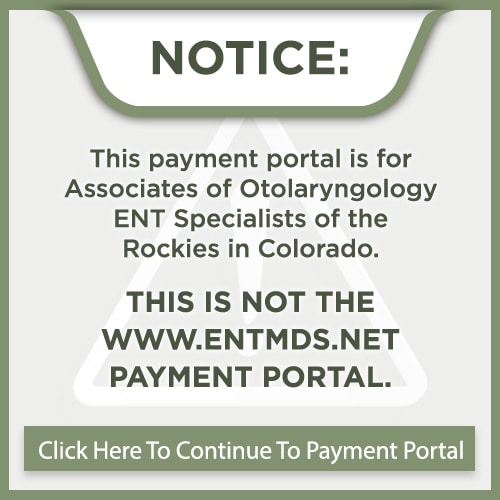Recent studies by otolaryngologist–head and neck surgeons have better defined the association between rhinitis and sinusitis (sinus infection). They have concluded that sinusitis is often preceded by rhinitis and rarely occurs without concurrent rhinitis. The symptoms, nasal obstruction/discharge and loss of smell, occur in both disorders. Most importantly, computed tomography (CT scan) findings have established that the mucosal linings of the nose and sinuses are simultaneously involved in the common cold (previously thought to affect only the nasal passages). Otolaryngologists, acknowledging the inter-relationship between the nasal and sinus passages, now refer to sinusitis as rhinosinusitis.
The catalyst relating the two disorders is thought to involve nasal sinus overflow obstruction, followed by bacterial colonization and infection, leading to acute, recurrent, or chronic sinusitis. Likewise, chronic inflammation due to allergies can lead to obstruction and subsequent sinusitis.
Other medical research has supported the close relationship between allergic rhinitis and sinusitis. In a retrospective study on sinus abnormalities in 1,120 patients (from two to 87 years of age), thickening of the sinus mucosa was more commonly found in sinusitis patients during July, August, September, and December, months in which pollen, mold, and viral epidemics are prominent. A review of patients (four to 83 years of age) who had surgery to treat their chronic sinus conditions revealed that those with seasonal allergies and nasal polyps are more likely to experience a recurrence of their sinusitis.
How Your Respiratory System Works and Doesn’t Work When It’s Sick
The body’s nasal, sinus, and lung membranes have similar responses to viruses, allergic insults, and common bacterial infections. Membranes become swollen and congested. This congestion causes pain and pressure; mucus production increases during sinus inflammation, resulting in extra nasal and chest secretions. These secretions may thicken over time, may slow in their drainage, and may predispose to future bacterial infection of the respiratory system. This applies to the nose, throat, and lungs.
Congestion of the nasal membranes may even block the Eustachian Tube leading to the ear, resulting in a feeling of blockage in the ear or fluid behind the eardrum. Additionally, nasal airway congestion causes the individual to breathe through the mouth.
Each year, more than 50 million Americans seek treatment for sinusitis. They typically complain of nasal congestion, thick yellow-green nasal discharge, facial pain, and pressure. Many do not understand the nature of their illness or what produces their symptoms.
Sinuses are air-filled cavities in the skull. Portions of the sinus cavities occupy part of the top of the nose in the middle of your face between your eyes, but other sinuses connect to your nose through small passageways into your forehead, cheek, and skull bone in the back of your nose. The connecting passageways have dual purposes in that they allow mucus that is normally formed in the sinuses to exit and also allow air pressure equalization to occur between the nose, the environment outside your nose, and the sinuses. Blockages in the openings from swelling due to colds, flu, or allergies may lead to an acute sinus infection, which may include the symptoms of increased thick drainage, headache, facial pain, vision changes, and many other symptoms. Sinus complaints at this time are the most common problem for which adult patients seek medical care in the United States!
How Do I Know If I Have a Sinus Infection?
Many patients are unsure if they have a nose problem or a sinus problem. In fact, the nose and the sinuses are intimately related, and infection or problems with either may easily affect the other. Many other patients are unaware that they have sinus problems at all and have gone on for years believing that they have migraine headaches, uneven vision, or sore teeth. It is not wise to make any assumptions about chronic nose problems, headaches, facial pain, or any related symptoms without seeking the evaluation and advice of your physician.
Acute bacterial sinusitis is a bacterial infection of the sinus cavities. It usually precedes a cold, allergy attack, or irritation by environmental pollutants. Unlike a cold or allergy, bacterial sinusitis requires a physician’s diagnosis and treatment with an antibiotic to cure the infection and prevent future complications.
Normally, mucus collecting in the sinuses drains into the nasal passages. However, when you have a cold or allergy attack, your sinuses become inflamed and are unable to drain, leading to congestion and infection. Diagnosis of acute sinusitis, complicated acute sinusitis, or subacute sinusitis is usually based on a physical examination and a discussion of your symptoms. Your doctor may also use CT imaging of your sinuses or obtain a sample of your nasal discharge to test for bacteria.
A viral “cold” that persists for ten days or more may have become an acute bacterial sinus infection. With this infection, you may notice increased post-nasal drip. If you suspect that you have a sinus infection, you should see your physician for evaluation.
Common symptoms of sinusitis include:
- Post-nasal drip
- Runny nose
- Stuffy nose
- Ear pressure or pain
- Fever
- Pressure or pain in your teeth
- Facial pressure
- Cough
- Headache
- Tiredness
What is Chronic Sinusitis?
When you have frequent sinusitis or the infection lasts three months or more, it could be what is called chronic sinusitis. Symptoms of chronic sinusitis may be less severe than those of acute sinusitis; however, untreated chronic sinusitis can cause damage to the sinuses and cheekbones that sometimes requires surgery to repair.
Chronic Sinusitis occurs when sinus blockages persist, either due to anatomical issues such as a deviated nasal septum or swelling, and the lining of the sinuses swells further than it may have during an acute infection. Generally, patients with chronic sinus problems have been experiencing discomfort for at least three months without significant relief from antibiotics or other treatments. Polyps (growths in the nose) may develop with chronic sinusitis. Patients with polyps tend to have irritating, persistent post-nasal drip. Evaluation by an otolaryngologist may include an exam of the interior of the nose with a fiberoptic scope and CT scan. If medication does not relieve the problem, surgery may be recommended.
Why Do I Have Chronic Sinusitis, and What Can I Do About It?
The astute ENT (ear, nose, and throat) doctor will be considering many factors that predispose patients to sinus disease, particularly chronic infections. We know from intensive studies in the last decade that the lungs and the sinuses are very similar and, in fact, are inextricably linked. Asthma and chronic sinus disease will aggravate each other if either is left untreated. Environmental allergies will make management of chronic sinus disease hopeless if left untreated. Medication allergies can also cause swelling in the nose. This is sometimes seen with subtle allergies to aspirin and other nonsteroidal anti-inflammatory medications such as ibuprofen or Naprosyn sodium. Immune dysfunction, even subtle, which otherwise leaves a patient healthy and with a normal lifespan, can wreak havoc on sinus function. Connective tissue diseases, such as those that cause arthritis or autoimmune reactions, can first manifest as sinus disease.
All of these and more are addressed during a thorough sinus disease workup. Imaging in the form of CT or MRI will help to identify anatomical changes that predispose some patients to sinus infection. Appropriate medical treatment often involves several different types of topical nasal sprays, systemic oral therapies, and frequent cultures of nasal secretions to identify uncommon pathogens. Molds and other unsuspected bacteria that otherwise might not be thought to grow in the nose are often found in chronically ill sinus patients. Overall, different types of sinusitis may occur, including the following:
Bacterial Sinusitis
Therapy for bacterial sinusitis should include an appropriate antibiotic, which cannot be based on guesswork alone. If you have three or more symptoms of sinusitis (see chart), be sure to see your doctor for a diagnosis. Antibiotics offered without the use of culture to identify the offending organism may be an unnecessary risk to your well-being and will likely prolong, if not worsen, your suffering. In addition to an antibiotic, proper nasal hygiene with the use of saline rinses and appropriate topical sprays should be recommended and maintained, often indefinitely. In cases of viral sinusitis, antibiotics will not be effective.
Antibiotic Resistance
Antibiotic resistance means that some infection-causing bacteria are immune to the effects of certain antibiotics prescribed by your doctor. Antibiotic resistance is making even common infections, such as sinusitis, challenging to treat. You can help prevent antibiotic resistance. Maintain your own motivation for getting a culture, following through on the results, and taking the full course of a carefully selected antibiotic. It is important that you take all of the medication just as your doctor instructs, even if your symptoms are gone before the medicine runs out, in order to prevent further resistance of the bacteria growing in your nose and sinuses, which may not any longer be causing you symptoms but are waiting for an opportune time to cause you trouble in the future.
Fungal Sinusitis
Fungal sinusitis is a type of sinus infection caused by a fungal infection. A fungus is a living organism that can live in the air, on surfaces, and on humans or animals. Fungal sinus infections can be classified as invasive and noninvasive and may include allergic fungal rhinosinusitis, fungal ball (mycetoma), and saprophytic fungal sinusitis. Most fungal sinus infections are noninvasive and can result in a variety of uncomfortable symptoms, such as pressure in the sinus areas, nasal congestion, nasal polyps, mucus buildup, and more. Treatment for fungal sinusitis may include antifungal medications, corticosteroids, nasal washes, and surgery.
Sinusitis Procedures
Surgery is sometimes necessary to remove physical obstructions that may contribute to sinusitis. Surgery should be considered only if medical treatment fails or if there is a nasal obstruction or abnormal sinus structures that cannot be corrected with medications, such as a deviated nasal septum. The type of surgery is chosen to best suit the patient and the disease. Almost always, the surgery is performed through the nose, without external incisions, bruising, swelling, or other temporary appearance alterations.
Functional endoscopic sinus surgery (FESS) is recommended for most types of sinus disease. With the endoscope, the surgeon can look directly into the nose while at the same time removing diseased tissue and polyps and clearing the narrow channels between the sinuses. This is performed under general anesthesia with special microscopic instruments to preserve the important normal structures inside the nose.
Before surgery, be sure that you have realistic expectations for the results, recovery, and postoperative care. Good results require not only good surgical techniques but a cooperative effort between the patient and physician throughout the healing process. It is equally important for patients to follow pre- and postoperative instructions. Sinus surgery is unique in this regard; patient and surgeon relations must continue for quite some time after the procedure to ensure the best long-term results.
Preventing Sinusitis
As always, an ounce of prevention is worth a pound of cure. To prevent sinusitis during a cold or allergy attack, keep your sinuses clear by:
Maintaining excellent nasal hygiene. Use a twice-daily, large-volume nasal rinse to purge your nose of external irritants. Considering the long-term use of topical anti-inflammatory and antihistamine sprays to keep nasal mucus membranes in optimum condition, avoid systemic medications that will cause nasal dryness or swelling. These include the regular use of decongestants, antihistamines, certain sleeping aids, and over-the-counter cold and sinus remedies, drinking plenty of fluids to keep nasal discharge thin, and managing your environmental allergies (see our allergy section).
Children & Sinusitis
Your child’s sinuses are not fully developed until beyond age 20. However, children can still suffer from sinus infections. Although small, the maxillary (behind the cheek) and ethmoid (between the eyes) sinuses are present at birth. Sinusitis is difficult to diagnose in children because respiratory infections are more frequent, and symptoms can be subtle. Unlike a cold or allergy, bacterial sinusitis requires a physician’s diagnosis and treatment with an antibiotic to prevent future complications.
The following symptoms may indicate a sinus infection in your child:
- A “cold” lasting more than 10 to 14 days, sometimes with low-grade fever.
- Thick yellow-green nasal drainage.
- Post-nasal drip, sometimes leading to or exhibited as sore throat, cough, bad breath, nausea, and/or vomiting.
- Headache, usually not before age 6.
- Irritability or fatigue.
- Swelling around the eyes.
If, despite appropriate medical therapy, these symptoms persist, care should be taken to seek an underlying cause. The role of allergy and frequent upper respiratory infections should be considered.
Frequently Asked Questions
Can you have sinus headache without congestion?
Does sinus CT scan show teeth?
How do you know if you have a bacterial sinus infection?
What causes bacterial sinusitis?
What is sinusitis symptoms and treatments?
What is the first sign of sinusitis?
What happens if you let a sinus infection go untreated?
What is the fastest way to get rid of a sinus infection?
What should I do if I have sinusitis?
Can a sinus infection spread through your body?
Can an ENT drain your sinuses?
Can I beat a bacterial sinus infection without antibiotics?
Do I have a cold or sinus infection?
How do doctors test for sinus infection?
How does ENT check sinus?
How long are you contagious when you have a sinus infection?
Can blocked sinuses cause headaches?
Can you go to work with sinusitis?
Does brain MRI show sinus infection?
How can I unblock my sinuses?
How do you get sinusitis?
What is the best decongestant?
Which tooth is closest to maxillary sinus?
What triggers sinus headaches?
Will a CT scan show fungal sinusitis?
What is the best cure for sinusitis?
Can a sinus infection clear up on its own?
Can you catch sinusitis?
Do I need antibiotics for a sinus infection?
How do you tell if a sinus infection is viral or bacterial?







